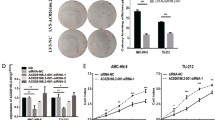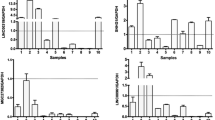Abstract
Purpose
Laryngeal cancer has a poor prognosis when progressing to an advanced stage with limited treatment options. Therefore, understanding the underlying mechanisms is important to identify novel treatment targets. Long non-coding RNAs (lncRNAs) have been shown to play oncogenic roles in cancer, including in laryngeal cancer. We previously discovered that the lncRNA RP11-297P16.3 is overexpressed in laryngeal squamous cell carcinoma (LSCC) based on RNA-sequencing data. Therefore, the aim of the present study was to investigate the effects of knockdown of RP11-297P16.3 on the migration and invasion of LSCC cells, and the significance of these effects.
Methods
Six methods were employed to assess the function of RP11-297P16.3 including gene silencing, RT-PCR, the 5-Ethynyl-20-deoxyuridine (EdU) staining assay, Scratch wound-healing assay, transwell assay, and Western blot.
Results
The results show that the expression of RP11-297P16.3 in the si-lncRNA group was significantly decreased compared with those in the BC (blank control) and NC (negative control) groups. Moreover, knockdown of RP11-297P16.3 significantly inhibited the migration and invasion of LSCC cells but had no effect on cell proliferation. The protein expression of N-cadherin and vimentin was notably decreased after RP11-297P16.3 knockdown; whereas, the protein expression of cadherin was significantly increased
Conclusion
These results suggested that RP11-297P16.3 may inhibit the migration and invasion of LSCC cells by regulating the epithelial–mesenchymal transition process, suggesting that RP11-297P16.3 is a potential new target for treating LSCC.






Similar content being viewed by others
Data availability
The datasets used and/or analyzed during the present study are available from the corresponding author on reasonable request.
References
Bray F, Ferlay J, Soerjomataram I, Siegel RL, Torre LA, Jemal A. Global cancer statistics 2018: GLOBOCAN estimates of incidence and mortality worldwide for 36 cancers in 185 countries. CA Cancer J Clin. 2018;68:394–424.
Hamilton DW, Bins JE, McMeekin P, Pedersen A, Steen N, De Soyza A, et al. Quality compared to quantity of life in laryngeal cancer: a time trade-off study. Head Neck. 2016;38(S1):E631-637.
Tamaki A, Miles BA, Lango M, Kowalski L, Zender CA. AHNS series. Do you know your guidelines? Review of current knowledge on laryngeal cancer. Head Neck. 2018;40(1):170–81.
Obid R, Redlich M, Tomeh C. The treatment of laryngeal cancer. Oral Maxillofac Surg Clin North Am. 2019;31(1):1–11.
Dudas J, Ladanyi A, Ingruber J, Steinbichler TB, Riechelmann H. Epithelial to mesenchymal transition. A mechanism that fuels cancer radio/chemoresistance. Cells. 2020;9(2):428.
Brabletz T, Kalluri R, Nieto MA, Weinberg RA. EMT in cancer. Nat Rev Cancer. 2018;18(2):128–34.
Goodall GJ, Wickramasinghe VO. RNA in cancer. Nat Rev Cancer. 2021;21(1):22–36.
Grixti JM, Ayers D. Long noncoding RNAs and their link to cancer. Noncoding RNA Res. 2020;5(2):77–82.
Dykes IM, Emanueli C. Transcriptional and post-transcriptional gene regulation by long non-coding RNA. Genom Proteom Bioinf. 2017;15(3):177–86.
Li W, Chen Y, Nie X. Regulatory mechanisms of lncRNAs and their target gene signaling pathways in laryngeal squamous cell carcinoma. Front Pharmacol. 2020;11:1140.
Cossu AM, Mosca L, Zappavigna S, Misso G, Bocchetti M, De Micco F, et al. Long non-coding RNAs as important biomarkers in laryngeal cancer and other head and neck tumours. Int J Mol Sci. 2019;20(14):3444.
Wu Y, Zhang Y, Zheng X, Dai F, Lu Y, Dai L, et al. Circular RNA circCORO1C promotes laryngeal squamous cell carcinoma progression by modulating the let-7c-5p/PBX3 axis. Mol Cancer. 2020;19(1):99.
Wu Y, Zhang Y, Niu M, Shi Y, Liu H, Yang D, et al. Whole-transcriptome analysis of CD133+CD144+ cancer stem cells derived from human laryngeal squamous cell carcinoma cells. Cell Physiol Biochem. 2018;47(4):1696–710.
Fabre AL, Colotte M, Luis A, Tuffet S, Bonnet J. An efficient method for long-term room temperature storage of RNA. Eur J Hum Genet. 2014;22(3):379–85.
Livak KJ, Schmittgen TD. Analysis of relative gene expression data using real-time quantitative PCR and the 2(-∆∆C(T)) method. Methods. 2001;25(4):402–8.
Zhang XC, Liang ZY, Wang SY, Lu S, Song Y, Cheng Y, et al. Application of next-generation sequencing technology to precision medicine in cancer: joint consensus of the Tumor Biomarker Committee of the Chinese Society of Clinical Oncology. Cancer Biol Med. 2019;2:189–204.
Pallasch FB, Schumacher U. Angiotensin Inhibition, TGF-β and EMT in Cancer. Cancers. 2020;12(10):E2785.
Zhao X, Yu D, Yang J, Xue K, Liu Y, Jin C. Knockdown of Snail inhibits epithelial-mesenchymal transition of human laryngeal squamous cell carcinoma Hep-2 cells through the vitamin D receptor signaling pathway. Biochem Cell Biol. 2017;95(6):672–8.
Mosca L, Minopoli M, Pagano M, Vitiello F, Vincenza M, Carriero MV, et al. Effects of S-adenosyl-l-methionine on the invasion and migration of head and neck squamous cancer cells and analysis of the underlying mechanisms. Int J Onco. 2020;56(5):1212–24.
Zhu GJ, Song PP, Zhou H, Shen XH, Wang JG, Ma XF, et al. Role of epithelial-mesenchymal transition markers E-cadherin, N-cadherin, β-catenin and ZEB2 in laryngeal squamous cell carcinoma. Oncol Lett. 2018;15(3):3472–81.
Gao W, Zhang C, Li W, Li H, Sang J, Zhao Q, et al. Promoter methylation-regulated miR-145-5p inhibits laryngeal squamous cell carcinoma progression by targeting FSCN1. Mol Ther. 2019;27(2):365–79.
Li J, Meng H, Bai Y, Wang K. Regulation of lncRNA and its role in cancer metastasis. Oncol Res. 2016;23(5):205–17.
Cantile M, Di Bonito M, Cerrone M, Collina F, De Laurentiis M, Botti G. Long non-coding RNA HOTAIR in breast cancer therapy. Cancers (Basel). 2020;12(5):1197.
Ghafouri-Fard S, Esmaeili M, Taheri M. H19 lncRNA: roles in tumorigenesis. Biomed Pharmacother. 2020;123:109774.
Zhang C, Shao S, Zhang Y, Wang L, Liu J, Fang F, et al. LncRNA PCAT1 promotes metastasis of endometrial carcinoma through epigenetical downregulation of E-cadherin associated with methyltransferase EZH2. Life Sci. 2020;243:117295.
Li CH, Chen YC. Targeting long non-coding RNAs in cancers: progress and prospects. Int J Biochem Cell Biol. 2013;45(8):1895–910.
Qu LM, Jin M, Yang LK, Sun CH, Wang P, Li YS, et al. Expression of long non-coding RNA HOXA11-AS is correlated with progression of laryngeal squamous cell carcinoma. Am J Transl Res. 2018;10(2):573–80.
Chen L, Xu Z, Zhao J, Zhai X, Li J, Zhang Y, et al. H19/miR-107/HMGB1 axis sensitizes laryngeal squamous cell carcinoma to cisplatin by suppressing autophagy in vitro and in vivo. Cell Biol Int. 2021;45(3):674–85.
Li R, Chen S, Zhan J, Li X, Liu W, Sheng X, et al. Long noncoding RNA FOXD2-AS1 enhances chemotherapeutic resistance of laryngeal squamous cell carcinoma via STAT3 activation. Cell Death Dis. 2020;11(1):41.
Cao J, Yang Z, An R, Zhang J, Zhao R, Li W, et al. lncRNA IGKJ2-MALLP2 suppresses LSCC proliferation, migration, invasion, and angiogenesis by sponging miR-1911-3p/p21. Cancer Sci. 2020;111(9):3245–57.
Wang R, Ma Z, Feng L, Yang Y, Tan C, Shi Q, et al. LncRNA MIR31HG targets HIF1A and P21 to facilitate head and neck cancer cell proliferation and tumorigenesis by promoting cell-cycle progression. Mol Cancer. 2018;17(1):162.
Gugnoni M, Ciarrocchi A. Long noncoding RNA and epithelial mesenchymal transition in cancer. Int J Mol Sci. 2019;20(8):1924.
Atefeh T, Mohsen M, Alireza M, Hassan MM, Mazaher A, Abolfazl A. Biological and clinical relevance of metastasis-associated long noncoding RNAs in esophageal squamous cell carcinoma: a systematic review. J Cell Physiol. 2020;2:848–68.
Monteiro-Reis S, Lobo J, Henrique R, Jerónimo C. Epigenetic mechanisms influencing epithelial to mesenchymal transition in bladder cancer. Int J Mol Sci. 2019;20(2):297.
Wang H, Qian J, Xia X, Ye B. Long non-coding RNA OIP5-AS1 serves as an oncogene in laryngeal squamous cell carcinoma by regulating miR-204-5p/ZEB1 axis. N-S Arch Pharmacol. 2020. https://doi.org/10.1007/s00210-020-01811-7.
Cui W, Meng W, Zhao L, Cao H, Chi W, Wang B. TGF-β-induced long non-coding RNA MIR155HG promotes the progression and EMT of laryngeal squamous cell carcinoma by regulating the miR-155-5p/SOX10 axis. Int J Oncol. 2019;54(6):2005–18.
Tong YX, Wang MH, Dai YN, Bao DJ, Zhang JJ, Pan HY. LncRNA HOXA-AS3 sponges miR-29c to facilitate cell proliferation, metastasis, and EMT process and activate the MEK/ERK signaling pathway in hepatocellular carcinoma. Hum Gene Ther Clin Dev. 2019;30(3):129–41.
Zheng TL, Zhang X, Wang DW, Xu J, Kou KJ, Wang ZW, et al. Overexpressed lncRNA GATA6-AS1 inhibits LNM and EMT via FZD4 through the Wnt/β-catenin signaling pathway in GC. Mol Ther-Nucl Acids. 2020;19(3):827–40.
Lan L, Cao H, Chi W, Meng WX, Zhao L, Cui W, et al. Aberrant DNA hypermethylation-silenced LINC00886 gene accelerates malignant progression of laryngeal carcinoma. Pathol Res Pract. 2020;13:152877.
Dhamija S, Diederichs S. From junk to master regulators of invasion: lncRNA functions in migration. EMT and metastasis Int J Cancer. 2016;139(2):269–80.
Funding
The study was funded by The Science and Technology Innovation Program for Colleges and Universities of Shanxi Education Department (Grant No. 2019L0411) and The National Natural Science Foundation of China (Gsrant No. 81902513).
Author information
Authors and Affiliations
Contributions
HW designed the study and wrote the manuscript. WW and JZ performed the experiments and statistical analyses. All authors read and approved the final manuscript.
Corresponding author
Ethics declarations
Conflict of interest
The authors declare that they have no competing interests.
Ethical approval
Not applicable.
Informed consent
For this type of study, formal consent is not required.
Patient consent for publication
Not applicable.
Additional information
Publisher's Note
Springer Nature remains neutral with regard to jurisdictional claims in published maps and institutional affiliations.
Rights and permissions
About this article
Cite this article
Wu, H., Wang, W. & Zhu, J. Knockdown of long non-coding RNA RP11-297P16.3 inhibits the migration and invasion of laryngeal squamous carcinoma cells. Clin Transl Oncol 23, 2057–2065 (2021). https://doi.org/10.1007/s12094-021-02609-6
Received:
Accepted:
Published:
Issue Date:
DOI: https://doi.org/10.1007/s12094-021-02609-6




